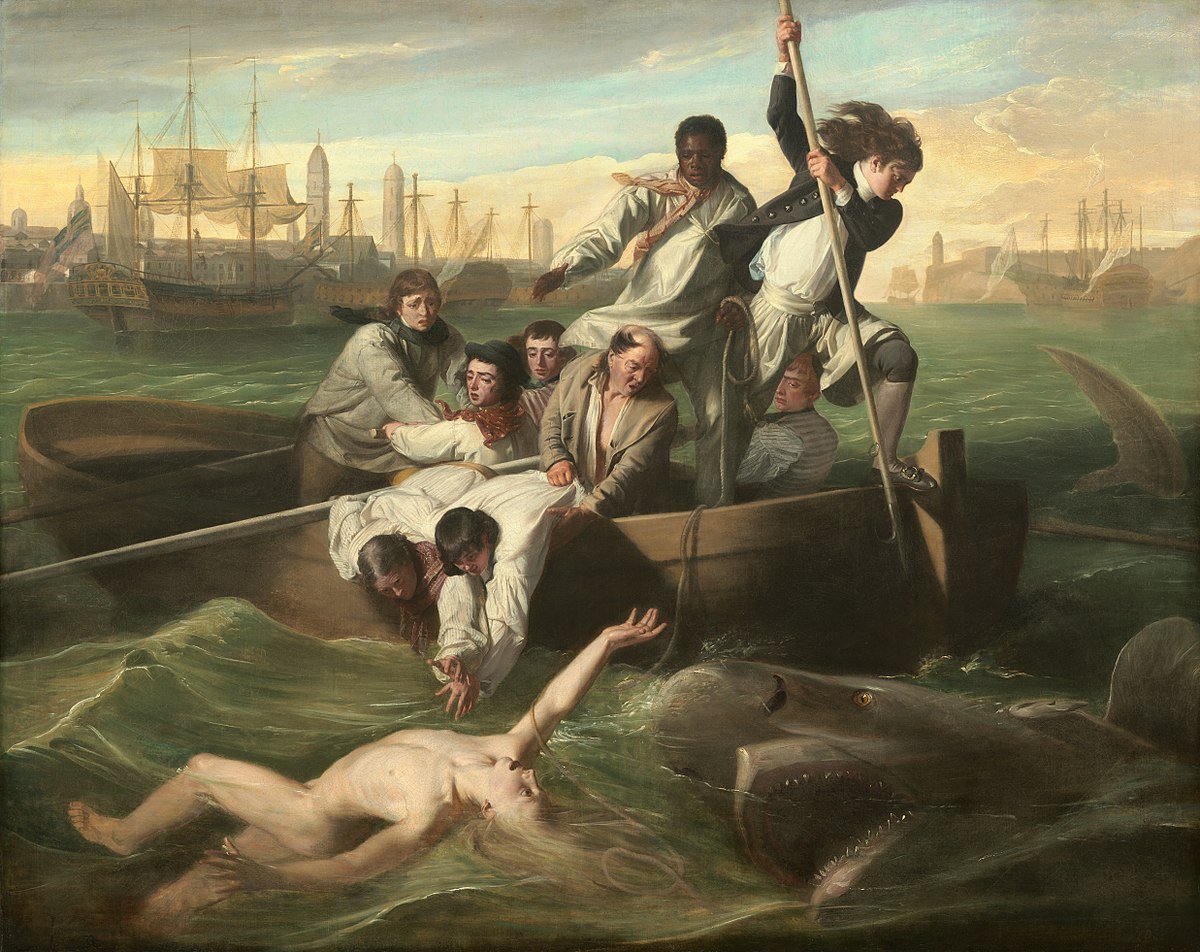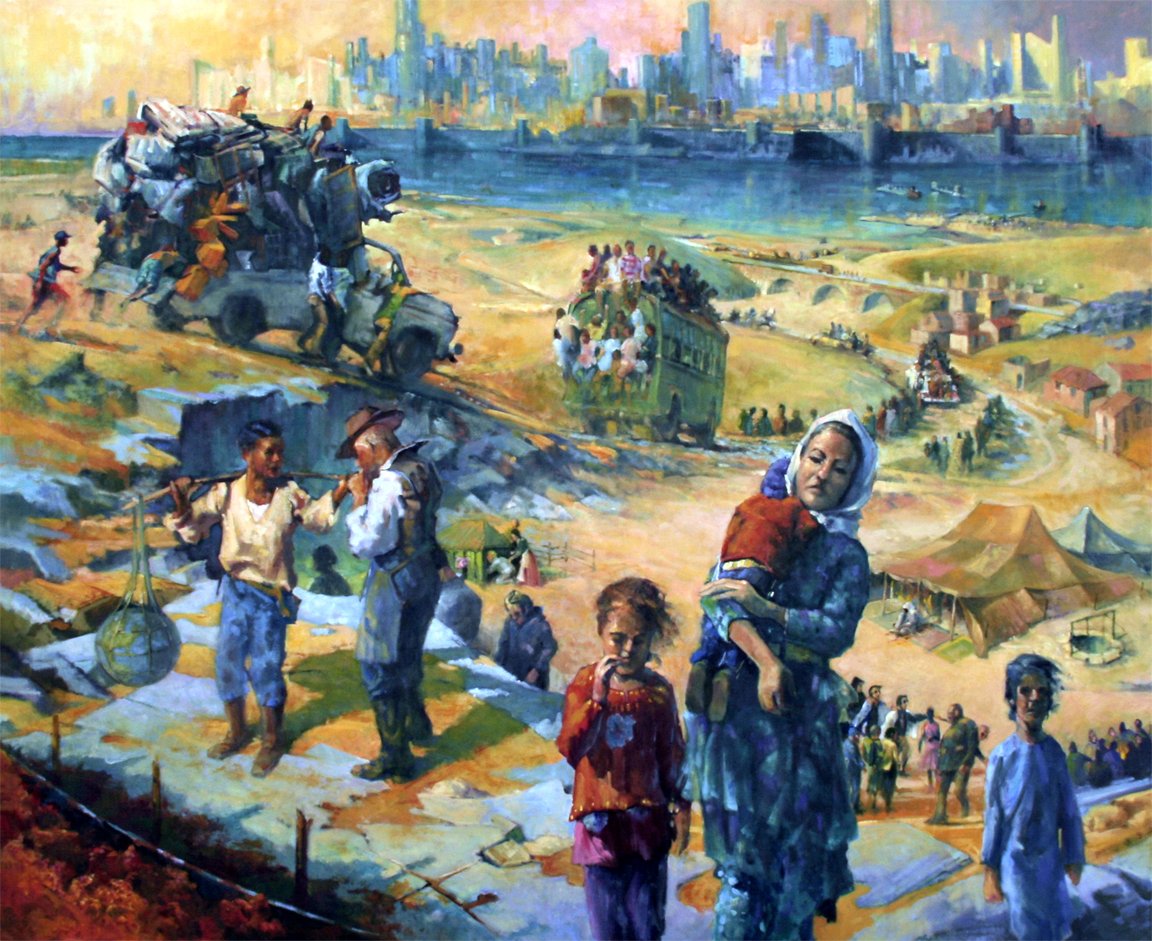RON JOHNSON FINE ART
SOCOTRA
oil on canvas 4x5’
“A FISH TALE”
oil on canvas 4x5’
Henri Rousseau, “The Dream”
John Singleton Copley, “Watson and The Shark”
Bruegel The Elder, “The Hunt”
“Deucalion and King Lycaon”
oil on canvas 4x5’
“Have and Not”
oil on canvas 4x5’
“Minos And The Shape Shifter”
oil on canvas 4x5’
“Polyeidus And Glaucous”
oil on canvas 5x4’
unknown artist Knossos, Crete
Caravaggio, “Supper At Emmaus”
“The Goat Boatman’s Tale”
oil on canvas 4x5’
“Oracle of Entanglement”
oil on canvas 4x3’
“Caravan”
oil on canvas 4x5’
Pasiphae’s apparatus sketches. Not used in
“Minos and the Shape Shifter”.
parts and pieces
unknown artist, circa 79ce, “Satyr”
Gustav Klimt, “Adele Bloch-Bauer”
Early sketches for “Have and Not”.
artist unknown, “Toy Ark Illustration”
Freedom Seekers
Brain storm ideas for
“Polyeidus and Glaucous”.
pieces and parts
Mixed Up Myths
MIXED UP MYTHS are stories about the past, present, and future. From its inception, the idea was to use memories and put them in a format that had no limits except my imagination which has many limitations. Including but not limited to sex, politics, religion, science, classical mythology, painting styles and periods, current events, humor, and some "et ceteras". Those ideas usually started after a lot of eclectic reading such as; James Joyce, Joseph Campbell, Believing Bullshit by Stephen Law, and Black Elk Speaks. No, Black Elk didn't write the book and Moses didn't write the first books of the Old Testament.
Maybe an event I encountered while out and about would spark a mental narrative of what could be. Once I got a chance to sit down and jot a few "what if tittles", I then developed sketches and notes about some non-defined place. A few became paintings. Most became wadded balls of pixels tossed into a laptop icon. Some sketches were developed. Most were discarded. The laptop allowed me to make changes with relative ease. Then document those ideas and take some of them in a new direction. Who knew? The internet became an incredible source for more ideas that I could develop later or not. There were no "thought bubbles" of the artist sketching at his/her drawing board, under a desk lamp surrounded by flying paper, bits and pieces of used pencils, erasers, ink, pens, and debris scattered about the garret. Just me, my bad typing, and my limited understanding of today's techno world. My laptop sketches helped me put the puzzle pieces together. That is not to say those sketches were close to the final product, but they did give me a good footing to build upon.
You know, most everything becomes a myth soon after it is sensed by one of us humans. Think about it. You are not AI. Your brain doesn't record an entire experience using all your senses. Rather, depending on the person, our five senses send signals to the brain. It processes the information, not as an iconic truth but rather as a memory. It doesn’t record the entire event and all its components. If it did, we would be reproducing an event in the same time and space that we occupy. There would be no memory or thought of the future because all would be everything at once. We wouldn't even know the event was happening because everything was happening at once.
Memories Are CliffsNotes
Images, words, smells, sounds, and feelings after a time seem to fit a narrative we form. Was it a black woman in a white car or a white woman in a black car? Now of course, we don't know for sure, but I think most would agree that any organism that has a brain does something just like we do and expresses itself in whatever way possible. Bowerbirds collect rocks, glass, and litter as jewels then display them around their homes just to get a little “nook nook”. Octopuses use textures, pulsing colorful patterned light, plus an array of other signals that are mind-boggling to humans. And, insects leave pheromone trails or do jitterbug dances that tell the tribe where the good stuff is. Most organisms do some sort of signaling to express how they feel. Humans are probably missing out on a lot of information. All those organisms are telling their stories and we just don't get it.
Memories are the past and the past is a myth. Humans tell the past with a variety of stories. Our senses gather the information and “we mix it all up and fry it in a pan”. Humans and some other animals have future myths. They usually start with a memory. Then we project ideas onto future events. Think about the Oracle of Delphi or a hawk predicting its diving path to intercept a pigeon at a predetermined location in space and time. The hawk is diving at 60 mph toward a pigeon flying at 15 mph 100 yards below. If the hawk misses the pigeon, he goes home and tells “the big one that got away" myth and the pigeon goes home and tells his kids about his heroic encounter with the "great beast".
As the work progressed parts and pieces were added, and pieces and parts were deleted as I could or could not fit them into the narrative. Fiction becomes truth. Instructions on how to put your new Ikea sofa together become an epic story of good conquering evil. My brain collated mental images to my active area of recall. Such as; art, history, politics, beliefs, sex, music, drugs, rock and roll. Plus a lot of "et ceteras". I allowed that if I ran across it in any media, memory, thought, or event I could include it in the painting or not. I could also stop at any time and restart at any time in the process of making the work. As time went on one idea begot another which could be developed as a new painting. Or, through the magic of mind, a new or secondary narrative could be added. I kept a diary, lots of sketches, and lots of references that came from the internet. Other sources like books, conversations, and many other modern-day ways we collect stuff were added to the potion. Remember that shiny object that you just had to have from Spencer's? Now it's stuffed behind the empty can of silly string on a shelf in your walk-in closet. That thing, whatever it was, could become the Mona Lisa at some point in the future. Sometimes that sort of thinking helps and sometimes not.
The Artist As An Old Man
Like James Joyce’s, “The Artist As A Young Man” I took my first steps, immediately fell down a rabbit hole, and was invited to a tea party. “Coo Coo Ca Choo”. Who are you? What did you do? Someone kept yelling, "You're late. You're late for a very important date". Running as fast as I could, I found myself right in front of a very large door with a very small keyhole. Peeking through the hole, I was immediately sucked in! Lying in his bed covered with blankets, leaning against several pillows and the headrest was old dark eyes himself. Aubrey the sickly illustrator. With his pen, ink, and paper he was sketching those dark drawings. Sensual drawings. And, I must say, better than Tenniel’s drawings for Alice. His lines seemed effortless, as they floated around the page. Flowers, gowns, curtains, and patterned wallpaper became visual descriptors. They weren't just named objects, but rather hieroglyphs that added a slightly different interpretation for the viewer. What surprised me most of all was the implied phallic symbols in almost every drawing. What!
Now This Is Different.
I remember the local library back in the day. It was one of the few places I could go. The books were full of those "words"... boring. I pillaged the tables and shelves looking through the art books; Da Vinci, Michelangelo, and Dali. They were "sweet spot on". From the second grade on, I was required to take every remedial reading class offered. Reading was never very good to me. Even today, it is “a thorn in my side”. Reading a paragraph 3 times could give me 3 different misunderstandings or adventures.
Not A Poet.
Hit by a car, then another
Afraid of a baseball, looked both ways
Saved, got a 3 speed,
Sat on a Vienna sausage can lid,
I had just eaten.
First stitches in Pilot Mountain,
Picked up BBQ takeout,
Biked down the hill BBQ in hand, oops
Landed on my stitches,
Cry of the banshee
It's alive! like a train
Roaring fowl spooked
Look, an island!
This magic moment, to sum it up
A spark, a stare, a pop
Goes the weasel
The thorn in my side
Was an applicator,
Bread and blood
In a cave, grotto, tomb,
The wine-dark Sargasso sea
In Shadow World,
Those with ears to hear
Must have a plan
Plato's "good" formed,
Unseen in light
You must have eyes to see.
Chain, chain, chain… chain of fools
Broken
Close the door, don't let the smoke out
"Don't let the sun go down on me".
Everything is "this magic moment"
If not for me, then Thee.
Things of the earth. Things in dark places.
Stone slabs over low spaces.
The hearth: embers, ashes, smoke, and flame hypnotizes. The storyteller moans and groans his tale. Add some aether, spiked wine, flickering shadows and you got yourself a church, hospital, laboratory, library, or hallowed hall.
I hear tell that long ago before his story, women were more powerful. Aphrodite, Medusa, and Medea were in their laboratories mixing and matching recipes for dinner and after-dinner treats. Their stew could put you in a stew. Their culinary magic; is ambrosia, nectar, the purple, a plaster, salve, or a wrap.
Ambrosia And Nectar
The two terms may not have originally been distinguished. Though in Homer's poems, nectar is usually the drink and ambrosia the food of the gods. It was with ambrosia that Hera "cleansed all defilement from her lovely flesh", and with ambrosia, Athena prepared Penelope in her sleep. So, when she appeared before her suitors, the effects of years had been stripped away. On the other hand, nectar is the food, and ambrosia is the drink. A character in Aristophanes' Knights says, "I dreamed the goddess poured ambrosia over your head—out of a ladle."
Homer speaks of ambrosial raiment, ambrosial locks of hair, and even the gods' wore ambrosial sandals. Athenaeus, Paulus, and Dioscurides employ it as a technical term in the contexts of cookery, medicine, and botany. Pliny used the term in connection with different plants, as did early herbalists.
Etymology
The concept of an immortality drink is attested in at least two ancient Indo-European languages: Greek and Sanskrit. The Greek ἀμβροσία (ambrosia) is semantically linked to the Sanskrit अमृत (amṛta) as both words denote a drink or food that gods use to achieve immortality. The two words appear to be derived from the same Indo-European form *ṇ-mṛ-tós, "un-dying" (n-: negative prefix from which the prefix a- in both Greek and Sanskrit are derived; mṛ: zero grade of *mer-, "to die"; and -to-: adjectival suffix). A semantically similar etymology exists for nectar, the beverage of the gods (Greek: νέκταρ néktar) presumed to be a compound of the PIE roots *nek-, "death", and -*tar, "overcoming".
What I'm saying is, that not only is myth "mixed up" or “concocted”, but it probably tells more truth than we would like to think.
Alpha Omega Potions.
These mythological paintings came from many places. Art history for one, but there were others; sex, politics, religion, the skin of a Newt, a bit of spit, a mollusk, an herb, a venom, a smoke-filled chamber, and a secret sauce. All are served up in an alabaster applicator. “A walk on the wild side”.
— Ouranos

























